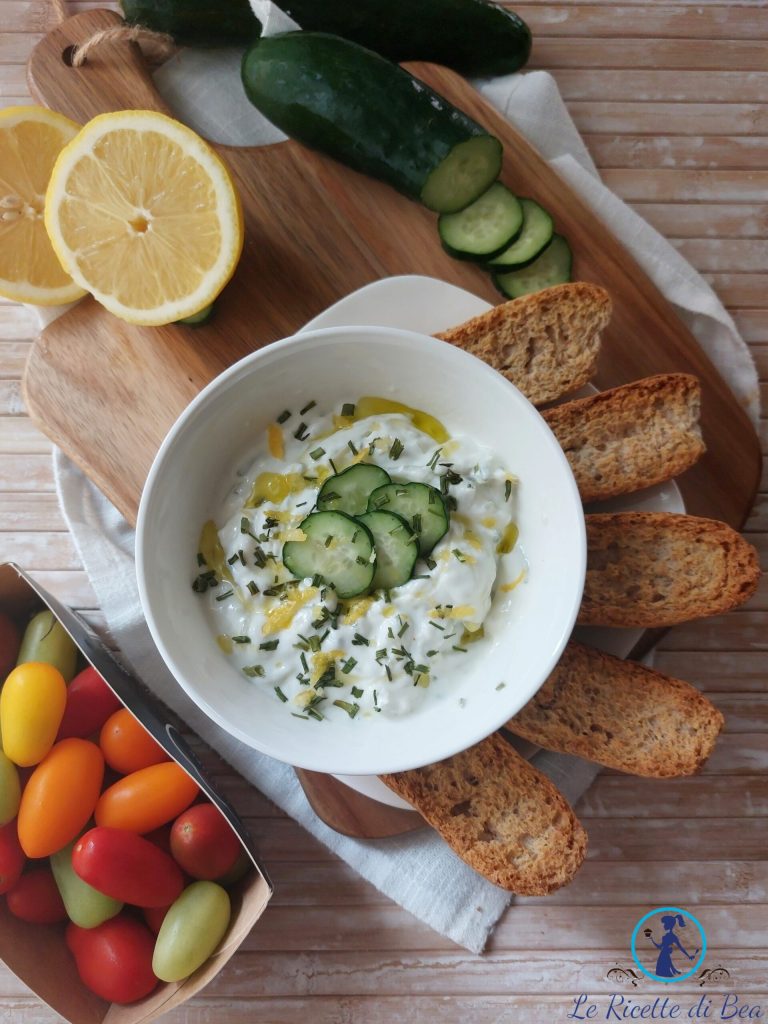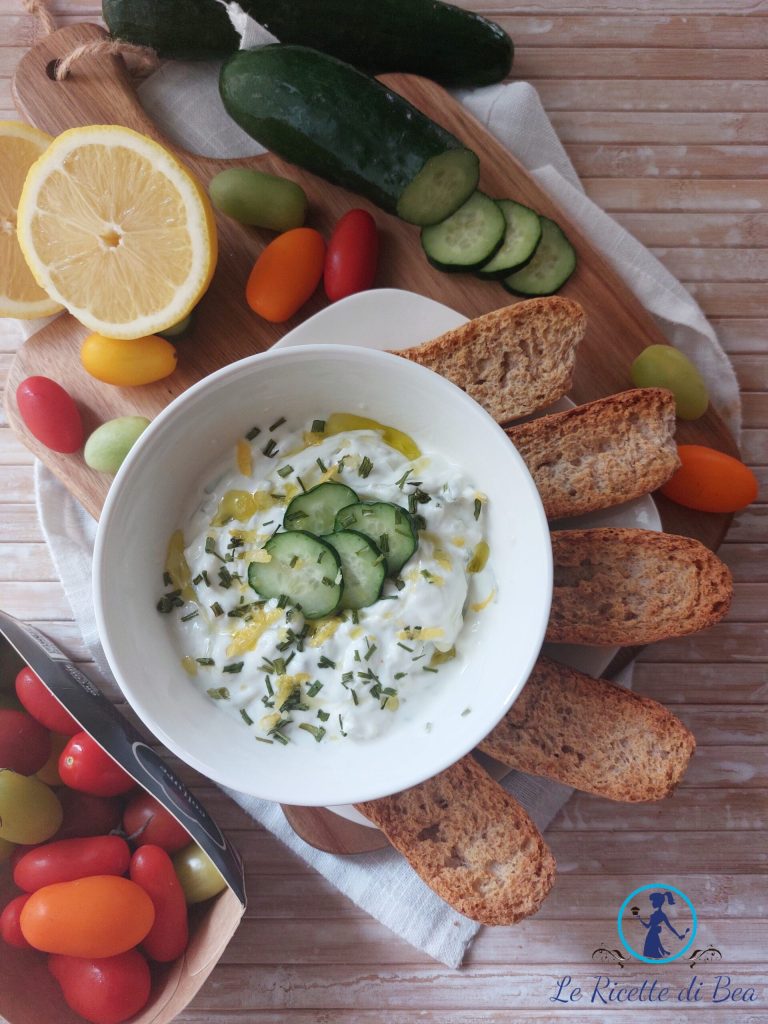Recipe for Greek Tzatziki Sauce with lemon juice and just a little garlic, easy to prepare, perfect as a summer appetizer or aperitif. Today, I’m bringing you another typical dish of Greek cuisine, one of the most well-known worldwide: the Greek tzatziki sauce.
I had the pleasure and honor of enjoying this dish prepared by the skilled hands of Albanian grandmothers and mothers, as you might imagine, being neighboring countries, they also had their own version of this tzatziki sauce. Small differences in ingredient quantities, I actually prefer it with much less garlic, but I think it’s simply because in my kitchen I already use very little.
The addition of lemon juice to replace or reduce the amount of vinegar and the chives captivated me. You can, of course, prepare the classic version with only white wine vinegar and use dill instead of chives. As with all recipes and all the many versions, you are free to vary the ingredients to suit your taste and pleasure!
Now, if we want to be precise, we must say that the amount of white wine vinegar needed to prepare the original Greek sauce recipe is about 10 grams or a heaping tablespoon. The dill is obviously used to garnish the dish, so just a light sprinkle. Regarding the Greek yogurt, the simple variation you can make is whether to use whole strained plain yogurt or go for the low-fat version, still strained Greek yogurt. To prepare this sauce, you should always and only use strained Greek yogurt, richer in fats, which will help you achieve the right and perfect consistency that this Greek sauce must have. Another fundamental step to give the right creaminess to our Greek dish is the timing. Unfortunately, yes, you will need to remember to grate the cucumber at least an hour before starting the preparation of the Greek sauce with yogurt. It must, in fact, be free of liquids, which it will start to release after it’s grated. Therefore, consider this resting time carefully.
But do you know why tzatziki sauce is prepared? It’s a special Greek sauce; this tzatziki sauce is served as an appetizer or aperitif or as a side dish for meat or fish dishes. There’s practically no meal that doesn’t start or end with Greek Tzatziki. Widely used in Greece, the Balkan countries, and the Middle East, it’s an easy-to-prepare sauce that is always accompanied by Pita (a typical Greek flatbread) or the more common bread. Black olives can also be added to give an even more Mediterranean touch to this recipe. There is also a version with mint and one with onion because each country has added its own authenticity.
Before moving on to the recipe for Tzatziki Sauce I’ve prepared today, I remind you that on the blog you can find many other recipes from Greek cuisine, Albanian cuisine, and Jewish cuisine, from appetizers to desserts:

- Difficulty: Very easy
- Cost: Very inexpensive
- Rest time: 1 Hour
- Preparation time: 10 Minutes
- Portions: 4 people
- Cooking methods: No cooking
- Cuisine: Greek
- Seasonality: All seasons
- Energy 186.90 (Kcal)
- Carbohydrates 9.10 (g) of which sugars 6.99 (g)
- Proteins 6.04 (g)
- Fat 14.79 (g) of which saturated 3.66 (g)of which unsaturated 0.02 (g)
- Fibers 0.61 (g)
- Sodium 122.00 (mg)
Indicative values for a portion of 100 g processed in an automated way starting from the nutritional information available on the CREA* and FoodData Central** databases. It is not food and / or nutritional advice.
* CREATES Food and Nutrition Research Center: https://www.crea.gov.it/alimenti-e-nutrizione https://www.alimentinutrizione.it ** U.S. Department of Agriculture, Agricultural Research Service. FoodData Central, 2019. https://fdc.nal.usda.gov
Ingredients
- 10.5 oz Greek yogurt (strained plain goat)
- 2 tbsps extra virgin olive oil
- 1 clove garlic
- 1 cucumber (medium-small, about 2.8 oz)
- 1 tbsp white wine vinegar (if preparing the original recipe, otherwise 1 tablespoon of lemon juice)
- 1 pinch salt
- as needed dill (if preparing the original recipe, otherwise chives as in my case)
- as needed lemon (a light grate of the peel)
Tools
- 1 Grater
- 1 Bowl
- 1 Knife
- 1 Plate
- 2 Spoons
- 1 Strainer
- 1 Cutting Board
Greek Tzatziki Sauce Recipe Steps
As indicated in the resting times, we must start preparing the Greek yogurt sauce at least an hour in advance of when it will be served. So if the aperitif is at 6 PM or dinner is at 8:30 PM, you need to start in advance because the cucumber needs to be free of liquids.
So let’s take the hand grater, if you want to buy the one I use, you can find it by clicking here, and a strainer. Grate the cucumber, a medium-small one, about 80 grams. Place the grated cucumber in a strainer and let it lose its liquid. This operation takes about an hour. It will help us not to have too many problems during the actual preparation of the Greek sauce. We must not have too much liquid component, otherwise, we risk an unbound and runny result.
After this period, give the cucumber a good squeeze with your hands to be sure it has lost all the excess liquid and proceed as follows. Take the garlic clove. If you have a mortar and pestle you can use it. I don’t have one (perhaps some kind soul will gift it to me in the future), so I do this step with a knife and a wooden cutting board. I remove the garlic skin and chop it into very small pieces.

Now take a bowl and pour in the grated cucumbers, now free of water, add the strained Greek yogurt, at least 300 grams, and the finely chopped garlic. Use a spatula to mix everything. Then add a tablespoon of extra virgin olive oil and the tablespoon of white wine vinegar. Sprinkle with a pinch of salt. This is the classic combination of aromas and flavors that the Greek tzatziki sauce should have. Before serving your aperitif, appetizer, or side dish of tzatziki sauce, sprinkle the surface with dill.
If you don’t like white wine vinegar like I do, you can replace it with the juice of a medium-small lemon. The sauce will still have a tangy note, but for me, it’s more tolerable than vinegar. The last ingredient you can substitute in the original version is chives instead of dill. Finely chop the chives and sprinkle the surface of the Greek Tzatziki sauce before serving it with pita or croutons as I do. Sooner or later, I’ll get the urge to make homemade pita! I’ll just remind you that I await you on my social channels with lots of food content and more, always live and with many curiosities from my kitchen! I wish you a good appetite and see you for the next recipe here on my blog Le Ricette di Bea!
Tips and variations:
As already indicated during the recipe preparation text, the variations are endless for this recipe. In fact, you only need to move from country to country, and you will find a different preparation or choice of ingredients. The only constant we can find is the use of goat or sheep yogurt, which is the base of this recipe but may not be to everyone’s liking. I have indicated in the list of necessary ingredients to use goat yogurt, but if you don’t like it or find it difficult to find in the supermarket, you can use classic strained Greek yogurt. If you don’t have the time or desire to make the Pita, you can accompany this sauce with toasted bread croutons, warmed flatbread cut into triangles, or classic packaged bread crostini. The Greek yogurt sauce pairs perfectly with meat and fish dishes.
FAQ (Questions and Answers)
If, like me, you have become curious and passionate about Greek cuisine, perhaps due to a trip or, as in my case, if you have or had a partner of Albanian, Greek, or Bulgarian origin, you cannot miss trying the typical sweet of the Balkan countries, the Baklava, by following the recipe you find on my cooking blog Le Ricette di Bea!

